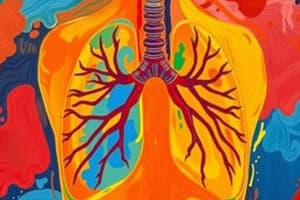Podcast
Questions and Answers
What does aerobic mean?
What does aerobic mean?
- a chemical reaction that releases energy
- without oxygen
- with oxygen (correct)
- a type of macromolecule
What does anaerobic mean?
What does anaerobic mean?
- without oxygen (correct)
- a type of supramolecular complex
- a chemical reaction that absorbs energy
- with oxygen
ATP is produced by the?
ATP is produced by the?
mitochondria
Carbon atoms have the bonding arrangement?
Carbon atoms have the bonding arrangement?
What is cellulose?
What is cellulose?
What is chromatin?
What is chromatin?
Closed systems can exchange?
Closed systems can exchange?
What do we call degradative, free-energy yielding reactions?
What do we call degradative, free-energy yielding reactions?
DNA is made up of monomeric subunits called?
DNA is made up of monomeric subunits called?
What happens in endergonic reactions?
What happens in endergonic reactions?
What happens in exergonic reactions?
What happens in exergonic reactions?
Facultative anaerobes can live with or without?
Facultative anaerobes can live with or without?
Interactions between biomolecules are?
Interactions between biomolecules are?
Isolated systems can exchange?
Isolated systems can exchange?
Macromolecules are joined by?
Macromolecules are joined by?
Mitochondria oxidize fuels to produce?
Mitochondria oxidize fuels to produce?
Obligate anaerobes die when exposed to?
Obligate anaerobes die when exposed to?
Open systems can exchange?
Open systems can exchange?
Phototrophs obtain energy from?
Phototrophs obtain energy from?
Ribosomes are the site of synthesis for?
Ribosomes are the site of synthesis for?
Smooth endoplasmic reticulum is the site of metabolism for?
Smooth endoplasmic reticulum is the site of metabolism for?
Smooth ER is the site of synthesis for?
Smooth ER is the site of synthesis for?
Synthetic reactions that require energy input are designated?
Synthetic reactions that require energy input are designated?
A chemical reaction that absorbs energy is?
A chemical reaction that absorbs energy is?
A chemical reaction that absorbs heat is termed?
A chemical reaction that absorbs heat is termed?
A chemical reaction that releases energy is termed?
A chemical reaction that releases energy is termed?
A chemical reaction that releases heat is termed?
A chemical reaction that releases heat is termed?
According to the first law of thermodynamics, forms of energy in the universe?
According to the first law of thermodynamics, forms of energy in the universe?
According to the first law of thermodynamics, the total amount of energy in the universe?
According to the first law of thermodynamics, the total amount of energy in the universe?
According to the second law of thermodynamics, the total entropy of the universe?
According to the second law of thermodynamics, the total entropy of the universe?
An example of a supramolecular complex is?
An example of a supramolecular complex is?
Enthalpy is negative for a reaction that?
Enthalpy is negative for a reaction that?
Enthalpy is positive for a reaction that?
Enthalpy is positive for a reaction that?
Entropy is negative for a reaction that?
Entropy is negative for a reaction that?
Entropy is positive for a reaction that?
Entropy is positive for a reaction that?
Molecules with the same chemical bonds and chemical formula but differ in the 3D spatial arrangement of atoms are called?
Molecules with the same chemical bonds and chemical formula but differ in the 3D spatial arrangement of atoms are called?
Flashcards are hidden until you start studying
Study Notes
Definitions and Concepts
- Aerobic refers to processes or reactions that occur in the presence of oxygen.
- Anaerobic indicates processes or reactions that occur without oxygen.
- ATP (Adenosine triphosphate) is produced by mitochondria and serves as a primary energy carrier in cells.
- Tetrahedral describes the bonding arrangement of carbon atoms, resulting in a three-dimensional shape.
- Cellulose is classified as a macromolecule, which plays a vital role in plant structure.
- Chromatin is a supramolecular complex composed of DNA and protein, organizing genetic material in eukaryotic cells.
- Closed systems can exchange energy but not matter with their surroundings.
- Catabolism denotes degradative reactions that yield free energy through the breakdown of complex molecules.
Reactions and Energy
- Nucleotides are the monomeric subunits that make up DNA, essential for genetic information storage.
- Endergonic reactions absorb energy from their surroundings, often requiring energy input to proceed.
- Exergonic reactions release energy, making it available for other processes.
- Facultative anaerobes thrive in both oxygen-rich and oxygen-limited environments, adapting to available resources.
- Interactions between biomolecules are described as stereospecific, highlighting the importance of three-dimensional arrangements.
Systems and Thermodynamics
- Isolated systems do not exchange energy or matter with their environment.
- Macromolecules are primarily joined by noncovalent interactions, affecting their structure and function.
- Mitochondria convert fuels into ATP through oxidation processes, essential for cellular energy supply.
- Obligate anaerobes are organisms that cannot survive in the presence of oxygen.
- Open systems can exchange both energy and matter, allowing interactions with their environment.
- Phototrophs derive energy from sunlight, utilizing photosynthesis to convert light energy into chemical energy.
Chemical Reaction Types
- Smooth endoplasmic reticulum is involved in drug metabolism and lipid synthesis, playing a role in detoxification and membrane production.
- Anabolism signifies synthetic reactions that require an input of energy, building complex molecules from simpler ones.
- Endothermic reactions absorb heat, while exothermic reactions release heat during chemical processes.
Laws of Thermodynamics
- The first law of thermodynamics states energy may change forms, but the total amount remains constant in the universe.
- The second law of thermodynamics asserts that total entropy, a measure of disorder, is continually increasing in the universe.
Thermodynamic Properties
- Enthalpy is negative for processes that release heat and positive for those that absorb heat.
- Entropy is negative for reactions that decrease randomness and positive for those that increase randomness.
- Stereoisomers are molecules that have the same chemical formula and bonding structure but differ in the three-dimensional arrangement of atoms.
Studying That Suits You
Use AI to generate personalized quizzes and flashcards to suit your learning preferences.




